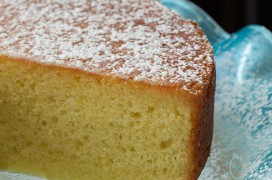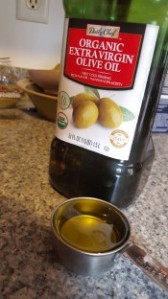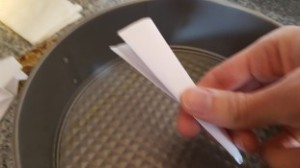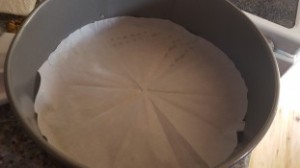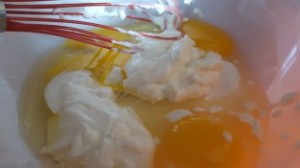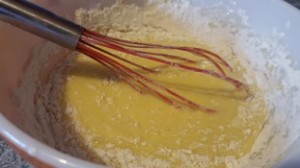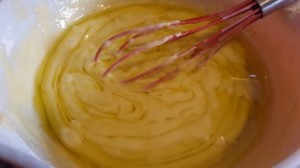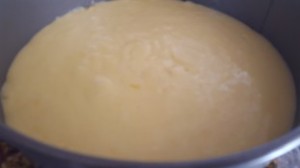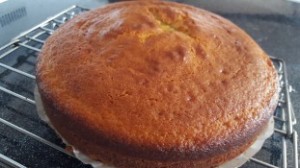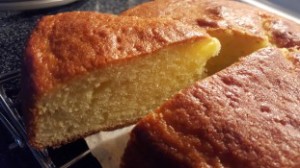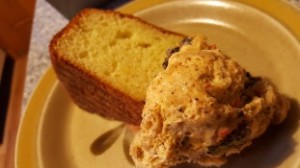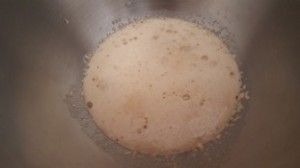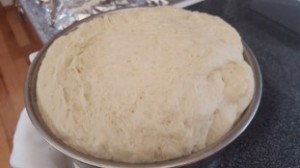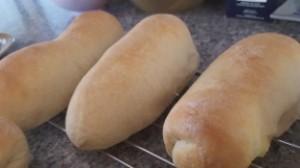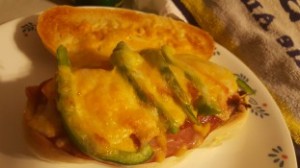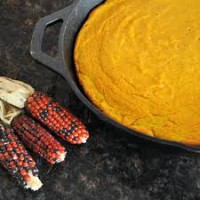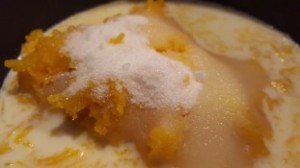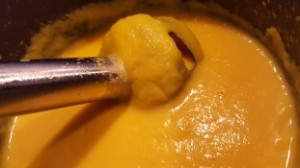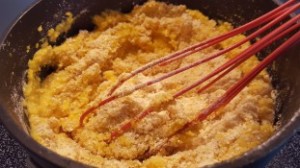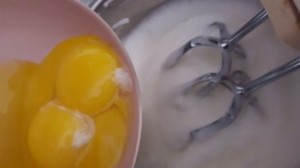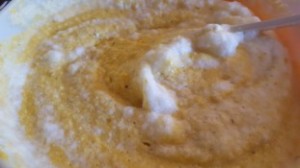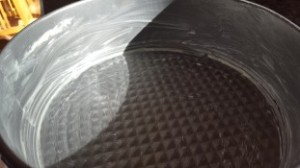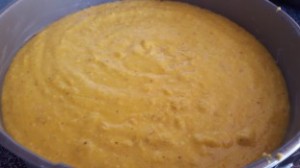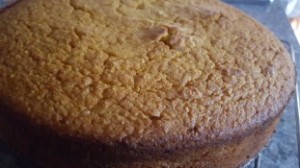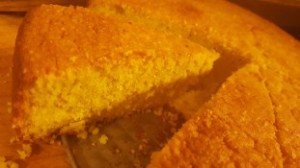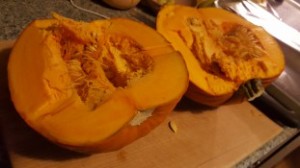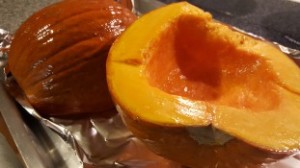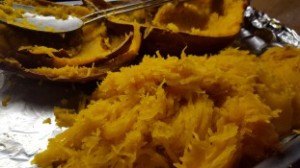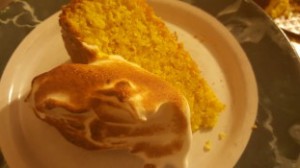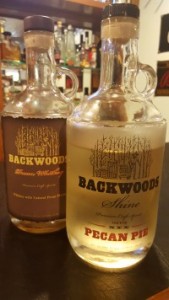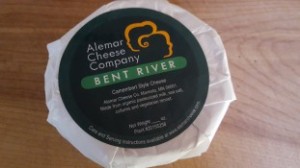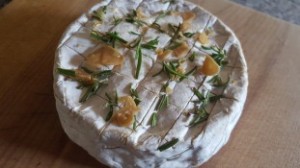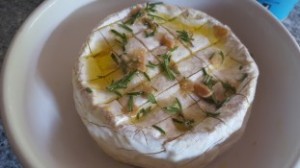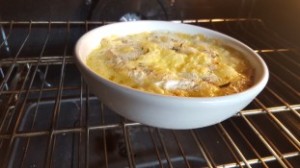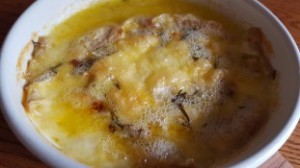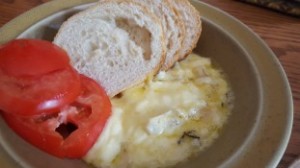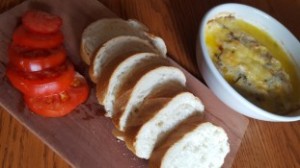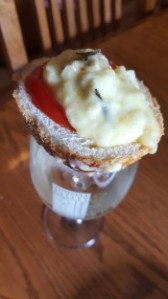The Sweet
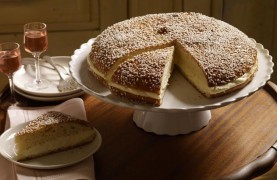 So for this week’s project, I had the mother take a look at my list of things and pick out a few things that sounded good. Which is how I ended up finally doing Baked Camembert, which I’ll be writing about soon, and the one dessert that she made mention of: Tarte Tropezienne. Which, and I’m glad she brought my attention to it considering I forgot, was a perfect sweet project to try considering my recent bread-based interests.
So for this week’s project, I had the mother take a look at my list of things and pick out a few things that sounded good. Which is how I ended up finally doing Baked Camembert, which I’ll be writing about soon, and the one dessert that she made mention of: Tarte Tropezienne. Which, and I’m glad she brought my attention to it considering I forgot, was a perfect sweet project to try considering my recent bread-based interests.
The ‘confection’ itself is basically a large, round Brioche-cake, sliced in half and filled with a particularly unique version of ‘buttercream’ or mousse. As such, with how it looks, Buzzfeed ended up describing it as ‘basically a giant cream puff,’ which is certainly true in one sense but completely off in another, but so can many things be. Either way it seems decadently-simple and sinful in buttery goodness.
Alexandra Micka is the inequitable source for where this pastry comes from. Of Polish origin, this baker move to St. Tropez in Provence during the 1950’s, after which he made the infamous cake in ’55 for the cast of a film production in the area. Obviously they completely adored it, and the name was supposedly suggested by the main actress at the time, Brigitte Bardot, most likely as a nod to the region (though interestingly, the name ends up translating to ‘roof pie’), even though technically it’s not really a tarte even as the French or English may widely define them.
Though that doesn’t make me want to attack it any less, so let’s get to the important parts of this briochy creation!
Chef’s Overdramatic Self-Centered Lecture Corner
It took me a while to whittle down and figure out what bread and ‘cream’ recipes I wanted to use, but there are a few things that helped narrow it down. First and foremost, one of the items I do believe I ran across was a mention that the original brioche recipe used was a ‘milk brioche,’ and despite my complete urge to go for this own really-decadent looking kind from a professional chef, he had absolutely no liquid in it at all besides eggs. So that was out. Afterward, I just had to go for something with a higher proportion of fat, eggs, and sugar, a Middle-Class/Rich-Man’s style, since it’d suit a dessert more and I really want to prove myself after my not-so-great Rich Man’s version that came out a couple months back. Found one that seemed good, was relatable to the one I originally enjoyed, and I even added an extra tablespoon of butter for good measure!
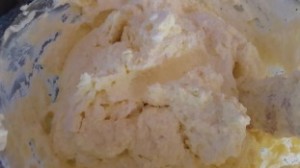 The second and more important part, in my opinion, is the filling… now, this isn’t just some simple frosting, or pastry cream, or anything like that. A few recipes will basically say, or make it look, like a pastry cream that is simply folded with whipped cream like a mousse; similar to what I once made for a Crepe Cake. But if one looks further, or at particular discussions of recipe and history, you might see the mention that the filling is truly a mixture of Pastry Cream, Buttercream, and sometimes also Whipped Cream. The French Wikipedia called for pastry cream + a term that LINKED to crème Chantilly, but translated to cream butter.
The second and more important part, in my opinion, is the filling… now, this isn’t just some simple frosting, or pastry cream, or anything like that. A few recipes will basically say, or make it look, like a pastry cream that is simply folded with whipped cream like a mousse; similar to what I once made for a Crepe Cake. But if one looks further, or at particular discussions of recipe and history, you might see the mention that the filling is truly a mixture of Pastry Cream, Buttercream, and sometimes also Whipped Cream. The French Wikipedia called for pastry cream + a term that LINKED to crème Chantilly, but translated to cream butter.
My first thought at this was that ‘Oh great, now I have to make pastry cream AND buttercream AND whipped cream and fold them all together.’ Ah, but then I found one article that featured what the actual technique was, calling it ‘German Buttercream,’ or something like that [of course I can’t find the recipe again NOW], or ‘Mousseline.’ Basically after making the pastry cream, instead of just immediately adding 1-2 pats of butter to melt in, one waits until it cools… and then beats in the equivalent of a whole stick, MINIMUM, until incorporated. Basically, it’s a Pastry Butter-Cream? And then of course one folds with whipped cream… you know, to make it ‘lighter.’ I just wanted to attack this head-on, so I found the one recipe that basically called for 3 whole sticks of butter to REALLY get this crossed effect, and it just so happened to be a rather egg-yolk rich cream, because that’s the kind of pastry cream I usually enjoy and felt like making this time.
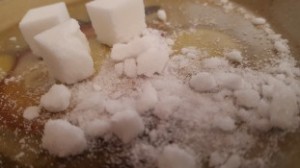 As you look through other recipes, you’ll see the consistent habit of sprinkling the top of the dough with an even layer of Pearl Sugar, those ubiquitous large crystals so famed in Eastern Europe for those waffles we love so much. As always though, they’re a pain to get a hold of; but luckily for us, it’s highly likely they aren’t REALLY all that classic and traditional, even if the chef was from Poland. It would be more likely that he used large-flake sugar or crushed up some compressed, so simply taking sugar cubes and crushing them up lightly would work just fine. At least that’s what I read in another article, I could be wrong here… it WAS only 60 years ago.
As you look through other recipes, you’ll see the consistent habit of sprinkling the top of the dough with an even layer of Pearl Sugar, those ubiquitous large crystals so famed in Eastern Europe for those waffles we love so much. As always though, they’re a pain to get a hold of; but luckily for us, it’s highly likely they aren’t REALLY all that classic and traditional, even if the chef was from Poland. It would be more likely that he used large-flake sugar or crushed up some compressed, so simply taking sugar cubes and crushing them up lightly would work just fine. At least that’s what I read in another article, I could be wrong here… it WAS only 60 years ago.
Finally, Orange Blossom Water! It’s the one oddly classic ingredient here, and some recipes won’t make mention and try to substitute it with ‘rum or kirsch,’ despite the fact that kirsch has been stated to not be traditional, especially in the much-further-southern region of origin. Though think of this now, it might not be too impossible… Polish baker, I could see him using Cherry Brandy… but orange blossom water is a DEFINITIE must-do, and you don’t want that delicate flavor to try crossing with other alcohols, especially when it’s so pricey why not just have it shine? As for WHAT it goes in, I’m not sure if it’s supposed to be solely in the bread, custard, or both… recipes differ, so I just went BOTH to really make sure you could taste it! Plus, I’ll admit, I did do ONE thing I’m almost 100% sure isn’t too classic, in that I made a simple orange syrup and then flavored it with more of the orange water, to which I soaked the cut bread with. But I haven’t made any bread/spongecake soaked with syrup yet, I thought it’d be fun… and again, make sure I didn’t screw up with too-light orange flavors. Hopefully it turns out.
Tarte Tropezienne
2½ tsp Dry Yeast
1/3 cup Milk, Warm
2 cups/275g, ish, AP Flour
3 Tb Sugar
2 Eggs + 1 for eggwash
½ tsp Sea Salt
2 tsp Orange Blossom Water
1 tsp Vanilla
8 Tb/1 Stick Butter, softened
1-3 Tb Crushed Sugar Cubes/Pearl Sugar
‘Mousseline,’ Recipe Follows
Orange Water Syrup, Recipe Follows
Directions
- Pour Warm Milk over Yeast, leaving for at least 5 minutes to dissolve and bloom
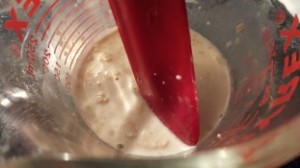
- Once done, combine with Flour, Sugar, Salt, 2 Eggs, Orange Water, Vanilla, and the 2 Eggs in a stand mixer, mixing on Low speed with the paddle attachment until everything is combined into a single ball/mass
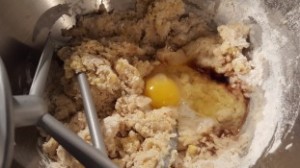
- Turn up to medium speed, slowly adding in small pats of butter one piece at a time, until fully incorporated and dough stretches from the sides
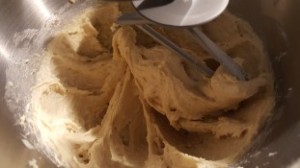
- Switch to a dough hook, start beating at medium-high speed for 5-10 minutes, adding more flour if too sticky, until the dough is smooth and, ideally, pulls away from the sides. It should pass the windowpane test if a small piece is very carefully stretched between fingers
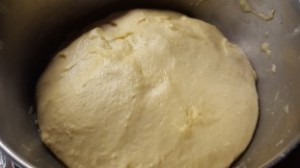
- Transfer to an oiled bowl, carefully turning to coat, and cover tightly with plastic
- Leave to bulk ferment at room temp for 1 hour, until about doubled in size, then move to fridge for overnight
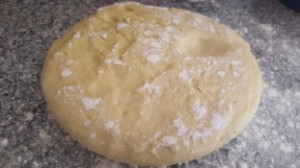
- Transfer onto a lightly floured surface the next day, dusting some more on top. Push down with your fingers to press out any excess gas, folding over if need be
- Swiftly but gently roll dough out into a circle-ish form at least 10” diameter
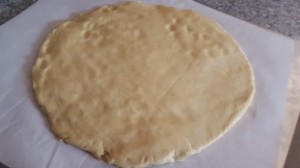
- Move onto a parchment-paper lined sheet tray and brush with a light layer of egg wash (the one egg, beaten with a bit of water). Leave at room temperature for at least 1 hour, until soft and hopefully risen a little bit
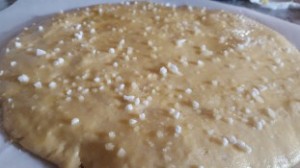
- Preheat oven to 400F
- When ready, brush another layer of egg wash over the top, sprinkling with Pearl Sugar or crushed Cube Sugar to create an ideally even coating
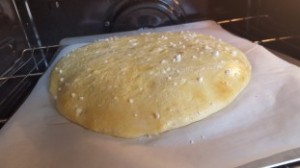
- Move into oven, immediately reducing the temperature to 350F. Let back 20-25 minutes, turning halfway through, until it’s developed a nice, thorough golden brown color on top and feels cooked when tapped
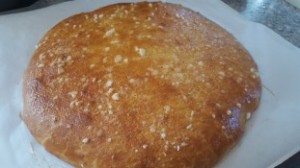
- Remove and let cool on the counter, 20 minutes minimum
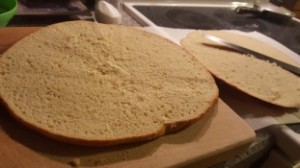
- Carefully slice, using a bread knife, in half, sawing horizontally along the edge to create a level cut from one side to the other
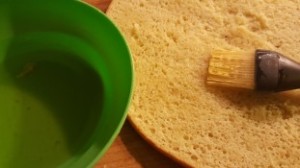
- Remove top, turning over, and brush the Orange Water Syrup over each side, soaking it evenly over the bread
- Take the reserved Mousseline and spread in an even, thick layer over the bottom piece, using as much as desired. Conversely, one can also pipe in, starting at the center to practice your motions and leaving the edge for some more attractive work (if the annoying makeshift piping bag will let you of course)
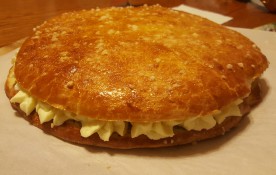
- Slice in wedges and serve
“Mousseline”/”Pastry Butter-cream Mousse” Filling
2 cups Milk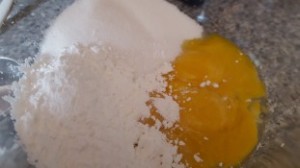
6 Egg Yolks
¾ cup Sugar
1/3 cup Cornstarch, Sifted
Tsp Salt
1 ½ cups/3 Sticks Butter, softened
1 Tb Orange Blossom Water
1 tsp Vanilla
¾ – 1 cup Heavy Cream
Directions
- Place Milk in pot over medium heat, leaving to scald/come to a simmer
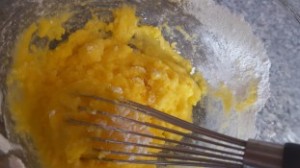
- On the side, combine the Yolks, Sugar, Corn Starch, and Salt, whisking until thoroughly mixed and pale yellow in color
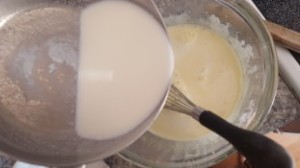
- When the milk is ready, remove from the stove and slowly pour into the egg mixture, whisking all the while to temper everything together carefully. Pour back into the pot and move back over heat
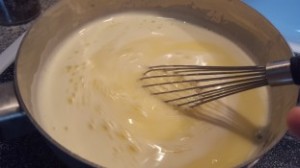
- Keep, whisking slowly at first while picking up the pace the longer and hotter it gets, making sure to keep it moving so none of it stays on the bottom or sides to scald or overcook, which will happen faster the thicker it gets
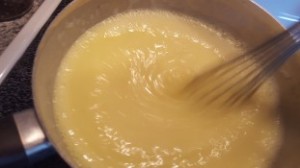
- As it starts to notably thicken, whisk fast and thorough, removing from the heat when it feels like it’s oneor two steps away from being a heavy cream [it will get to that point from continual cooking and when it cools]

- Quickly transfer to a bowl, straining if desired and/or worried about overcooking, and leave to cool on the counter
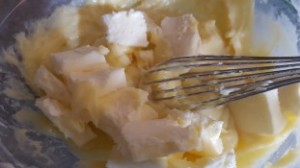
- When it’s down to room temperature, add in the Butter, Orange Water, and Vanilla, whipping it all thoroughly together with a whisk, or even an electric beater, until it’s all combined, ‘fluffy,’ and somewhat resembling buttercream
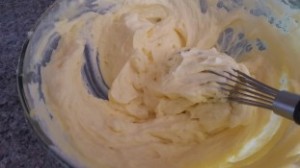
- Now start beating your Heavy Cream, ideally with a hand mixer to have it go faster, until it turns into Whipped Cream, drawing stiff peaks when moved; you’ll need about 1 ½ cups of it total
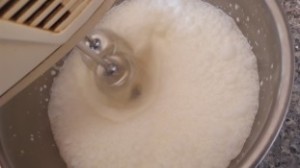
- Fold whipped cream in, 1/3 at a time, to make an aerated and fluffy ‘mousse’ of sorts
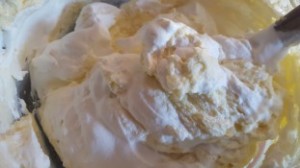
- Transfer to piping bag for use, storing in fridge if needed
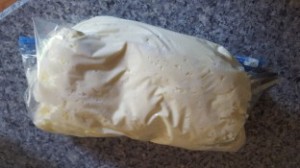
Orange Water Syrup
½ cup Water
¼ cup Sugar
Zest of 1 Orange
1 Tb Orange Blossom Water
Directions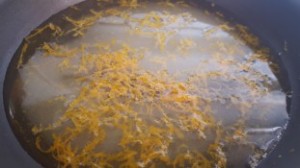
- Combine everything but the Orange Blossom Water in a pan, heat until it comes to a boil and the sugar is dissolved. Remove off to the side
- Once cooled, strain and add in the orange blossom water
My Thoughts
Well where to start… obviously it’s not as pretty as the other ones you see online; part of that being the sugar, pearl may not be ‘traditional’ but it gives the best effect. I really should get some soon, if anything to make those amazing Belgian waffles…
That and it’s too wide and thin… well, that was my thought, even after baking. But once it got cut, filled, and sliced into wedges, the inside actually looked a lot thicker than from outside, so on an everyday note I’m rather satisfied, but it’s still not as pretty as preferred. To fix, I should have probably fermented it in a smaller bowl, or folded it over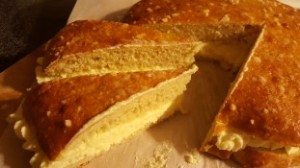 before rolling, or maybe just cut out the perfect circle from the rolled out dough; it was already at 10” just from the de-gassing stage. Though what I would have really liked to do was a little trick I read from a professional chef’s recipe where the dough is shaped inside of a tart mold rim; that way it stays a perfect circle, at the desired size, even when baking, and rises straight up like a cake! And I have springform pans, rather similar… but much taller circles than the tart pan rim, I was worried it wouldn’t bake right.
before rolling, or maybe just cut out the perfect circle from the rolled out dough; it was already at 10” just from the de-gassing stage. Though what I would have really liked to do was a little trick I read from a professional chef’s recipe where the dough is shaped inside of a tart mold rim; that way it stays a perfect circle, at the desired size, even when baking, and rises straight up like a cake! And I have springform pans, rather similar… but much taller circles than the tart pan rim, I was worried it wouldn’t bake right.
Speaking of which, it didn’t really rise while proofing… not much of an issue since it rose in the bake, but something doesn’t feel right, especially since it was still QUITE sticky; I’m positive I should have followed the technique in other recipes where you actually knead the dough to smooth, window-pane consistency first BEFORE adding the butter. That said, it turned out a lot better than the Rich Man’s Brioche I did earlier, was actually bread-like, though truthfully it could still be more Middle-Class level… if anything, I’m considering that I may have cooked it a little longer than I should have, and that’s the only real flaw I’ve found in final texture/flavor, proof-rise or no.
God-damn though was this thing rich!! Choosing the really eggy pastry cream recipe woulda been great if it was on its own, it tasted fantastic btw, but I probably should have gone a lighter version… and it was really cool trying out the buttercream-like technique, and that also was really good, but I think next time I’m gonna lean more towards the lower-butter recipes! Even after folding with the whipped cream, fatty enough as THAT was, put that between brioche bread and all you get is a mass of heavy fat and sugar; really good tasting, delicious mass, but believe me when I say a single slice will do you well for the night! I’m sure the tartes that are more well-done than mine are probably not so overwhelming, but I understand why I’ve seen quite a few that add strawberries and pistachios, to help cut through and then add texture (even with crunchy sugar, overwhelmingly one-note soft) in a tasty fashion.
There’s probably more to say, and done in a better and concise fashion, but I’m drawling out now… that frosting bread be weighing me down!
Possible Pairings
 With how rich and heavy this turned out, I don’t even think I want to think about dessert wine, or anything thick and sweet to drink with it. That said, one of the ‘classic’ pairings often mentioned to enjoy with it is a little dessert wine called Monbazillac, a smaller sub region very close to the oh-so-famous Sauternes in Bordeaux, the latter known for its rich, honeyed, and devilishly complex dessert wines based off Semillon and Sauvignon. Though, THAT is rather expensive, and even the really aged ones stay thick. Dessert wines from nearby regions however, such as Monbazillac, come in at some rather great price deals for the consumer, and usually end up a lighter-bodied and definitely reduced in sweetness, usually a nice simple sweet drink to enjoy chilled without much thought. So it really would fit this particular purpose quite well, especially if you made a better and more ideal tarte than I did!
With how rich and heavy this turned out, I don’t even think I want to think about dessert wine, or anything thick and sweet to drink with it. That said, one of the ‘classic’ pairings often mentioned to enjoy with it is a little dessert wine called Monbazillac, a smaller sub region very close to the oh-so-famous Sauternes in Bordeaux, the latter known for its rich, honeyed, and devilishly complex dessert wines based off Semillon and Sauvignon. Though, THAT is rather expensive, and even the really aged ones stay thick. Dessert wines from nearby regions however, such as Monbazillac, come in at some rather great price deals for the consumer, and usually end up a lighter-bodied and definitely reduced in sweetness, usually a nice simple sweet drink to enjoy chilled without much thought. So it really would fit this particular purpose quite well, especially if you made a better and more ideal tarte than I did!
Though really, at the end of the day: we need liquor. Non-sweet, cuttingly dry and high in spirit to help cut through all of that fatty, creamy texture and flavor. If Kirsch was actually used, as so many recipes keep saying even though, again, it’s not really regionally sound, it’d be the perfect pairing. Otherwise, a young Cognac, that hasn’t developed all that really deep and thick texture and ‘sweetness’ that the older ones have, would be great; though Armagnac would probably be better regionally, and the simpleness of the tarte would let the complexities of it shine, though its extra roughness in texture could overshadow that as well.
Or you could just make a Sidecar with Lemon Juice, Cognac, and Grand Marnier to bring out the orange notes in the dessert and still have that brandy flavor and aspect; and shaking these with ice will help lighten all the heaviness while still cutting through the custard some.
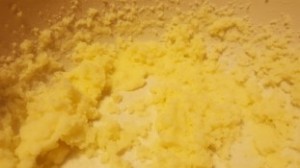

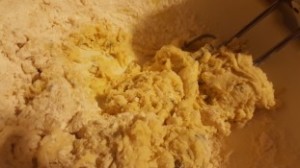
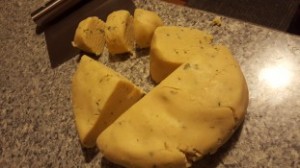
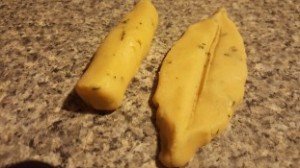
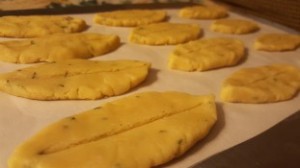
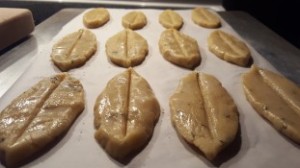
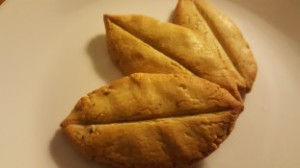
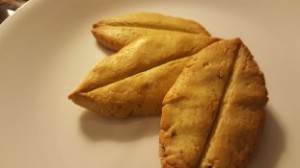 Though there’s also the chance that I could have heavily improved my odds, perhaps even fixed the issue altogether, by leaving the cookies thick, perhaps even shaping them as big as I originally wanted with the slit. Thus by the time it was ‘fully cooked’ and had a bit of browning on the very edge/bottom, the more voluminous insides would remain soft and tender as opposed to getting so firm.
Though there’s also the chance that I could have heavily improved my odds, perhaps even fixed the issue altogether, by leaving the cookies thick, perhaps even shaping them as big as I originally wanted with the slit. Thus by the time it was ‘fully cooked’ and had a bit of browning on the very edge/bottom, the more voluminous insides would remain soft and tender as opposed to getting so firm.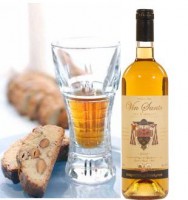 Speaking of dipping, ‘Vin Santo,’ an Italian dessert wine made by drying the grapes to concentrate their sugars and sweet flavors, is traditionally paired alongside biscotti for that exact purpose. And the flavor is amazing and deep. Perfect for these.
Speaking of dipping, ‘Vin Santo,’ an Italian dessert wine made by drying the grapes to concentrate their sugars and sweet flavors, is traditionally paired alongside biscotti for that exact purpose. And the flavor is amazing and deep. Perfect for these.

